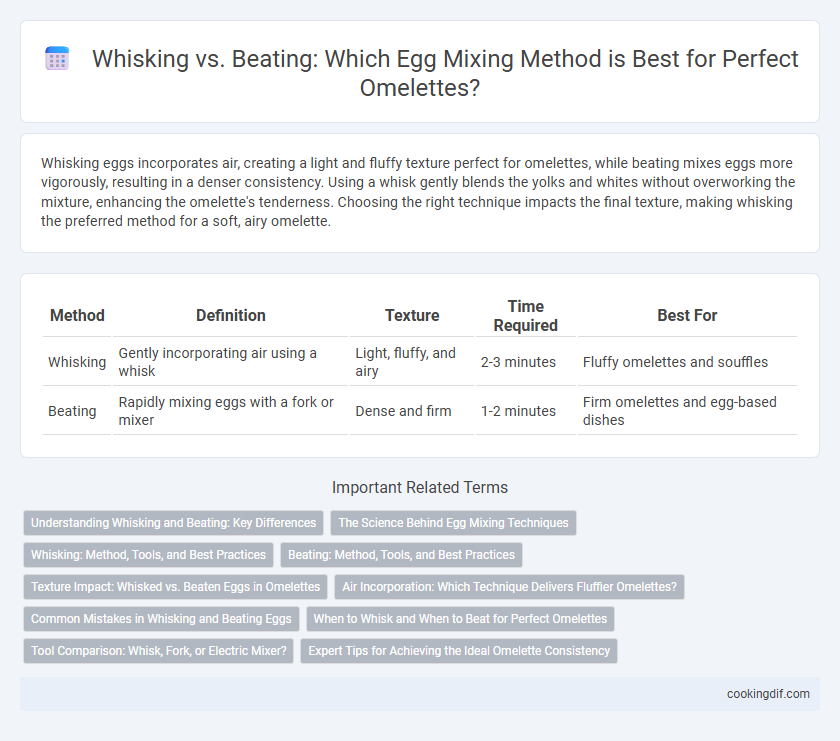Whisking eggs incorporates air, creating a light and fluffy texture perfect for omelettes, while beating mixes eggs more vigorously, resulting in a denser consistency. Using a whisk gently blends the yolks and whites without overworking the mixture, enhancing the omelette's tenderness. Choosing the right technique impacts the final texture, making whisking the preferred method for a soft, airy omelette.
Table of Comparison
| Method | Definition | Texture | Time Required | Best For |
|---|---|---|---|---|
| Whisking | Gently incorporating air using a whisk | Light, fluffy, and airy | 2-3 minutes | Fluffy omelettes and souffles |
| Beating | Rapidly mixing eggs with a fork or mixer | Dense and firm | 1-2 minutes | Firm omelettes and egg-based dishes |
Understanding Whisking and Beating: Key Differences
Whisking involves rapidly incorporating air into eggs using a wire whisk, creating a light, frothy texture essential for fluffy omelettes. Beating refers to mixing eggs vigorously with a fork or spoon to combine yolks and whites uniformly without incorporating significant air. Understanding these techniques helps achieve the desired omelette consistency, with whisking yielding aeration and beating producing a denser mixture.
The Science Behind Egg Mixing Techniques
Whisking eggs incorporates air into the mixture, creating a lighter, fluffier texture by breaking down protein strands and allowing them to trap air bubbles. Beating applies more forceful agitation, effectively blending yolks and whites evenly while developing a denser, silkier omelette structure. Understanding the science of egg protein denaturation and foam stability helps optimize texture and moisture retention in omelette preparation.
Whisking: Method, Tools, and Best Practices
Whisking eggs for omelettes involves using a balloon whisk to incorporate air, creating a light and fluffy texture essential for a tender dish. Optimal whisking technique includes brisk, circular motions to evenly combine yolks and whites without overbeating, which can toughen the eggs. Best practices recommend room temperature eggs and a deep mixing bowl to facilitate smooth aeration and prevent spillage during the whisking process.
Beating: Method, Tools, and Best Practices
Beating eggs for an omelette involves vigorously stirring to incorporate air and achieve a uniform mixture, often using tools like a fork, whisk, or electric mixer. Optimal beating requires consistent, rapid motions with a whisk to break yolks and whites thoroughly, creating a light texture that ensures a fluffy omelette. For best results, beat eggs just until combined to prevent over-aeration, which can cause uneven cooking or a rubbery texture.
Texture Impact: Whisked vs. Beaten Eggs in Omelettes
Whisking eggs incorporates air, resulting in a light, fluffy omelette texture with a tender crumb. Beating eggs more vigorously breaks down protein strands, creating a denser, firmer omelette structure. The choice between whisking and beating directly influences the omelette's mouthfeel and moisture retention.
Air Incorporation: Which Technique Delivers Fluffier Omelettes?
Whisking incorporates more air into eggs compared to beating, creating lighter, fluffier omelettes with a delicate texture. The rapid, circular motion of whisking breaks up egg proteins more effectively, trapping air bubbles that expand during cooking. Beating, while thorough in mixing, tends to produce denser omelettes due to less air incorporation.
Common Mistakes in Whisking and Beating Eggs
Whisking eggs incorporates air more gently, creating a light, fluffy texture ideal for omelettes, whereas beating eggs rapidly can result in over-mixing and a rubbery consistency. Common mistakes in whisking include insufficient motion and using the wrong tool, leading to uneven texture and poor volume. Beating errors often involve excessive speed and time, causing protein bonds to break down and resulting in tough, dense eggs instead of smooth, tender omelettes.
When to Whisk and When to Beat for Perfect Omelettes
Whisk eggs gently to incorporate air, creating a light and fluffy texture ideal for classic French-style omelettes. Beat eggs vigorously when aiming for denser, more uniform mixtures typical in American-style omelettes that hold fillings better. Understanding the difference in technique ensures optimal texture and taste in every omelette preparation.
Tool Comparison: Whisk, Fork, or Electric Mixer?
Whisking eggs with a balloon whisk incorporates more air, resulting in a fluffier omelette, while beating with a fork provides a quicker, less aerated mix suitable for denser textures. An electric mixer offers the most consistent and rapid results, efficiently combining eggs with other ingredients for a smooth, uniform batter. Choosing the right tool depends on the desired omelette texture and preparation time, with whisks favored for lightness, forks for simplicity, and mixers for speed and consistency.
Expert Tips for Achieving the Ideal Omelette Consistency
Whisking eggs incorporates air for a light, fluffy omelette texture, while beating vigorously breaks down proteins for a denser consistency often preferred in French-style omelettes. Experts recommend using a balloon whisk to gently incorporate air without overworking the eggs, ensuring a tender, smooth finish. Controlling the speed and duration of mixing directly impacts the omelette's fluffiness and creaminess, key factors in achieving the ideal texture.
Whisking vs Beating for egg mixing Infographic

 cookingdif.com
cookingdif.com